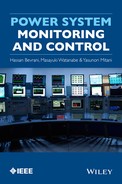Preface
Power system monitoring and control (PSMC) is an important issue in modern electric power system design and operation. It is becoming more significant today due to the increasing size, changing structure, introduction of renewable energy sources, distributed smart/microgrids, environmental constraints, and complexity of power systems.
The wide-area measurement system (WAMS) with phasor measurement units (PMUs) provides key technologies for monitoring, state estimation, system protection, and control of widely spread power systems. A direct, more precise, and accurate monitoring can be achieved by the technique of phasor measurements and global positioning system (GPS) time signal. A proper grasp of the present state with flexible wide-area control and smart operation addresses significant elements to maintain wide-area stability in the complicated grid, with the growing penetration of distributed generation and renewable energy sources.
In response to the existing challenge of integrating advanced metering, computation, communication, and control into appropriate levels of PSMC, this book provides a comprehensive coverage of PSMC understanding, analysis, and realization. The physical constraints and engineering aspects of the PSMC have been fully considered, and developed PSMC strategies are explained using recorded real data from practical WAMS via distributed PMUs and GPS receivers in Japan and Southeast Asia (Singapore, Malaysia, and Thailand). In addition to the power system monitoring, protection, and control, the application of WAMS in emergency control schemes, as well as the control of distributed microgrids, is also emphasized.
This book will be useful for engineers and operators in power system planning and operation, as well as for academic researchers. It describes both monitoring and control issues in power systems, from introductory to advanced steps. This book can also be useful as a supplementary text for university students in electrical engineering at both undergraduate and postgraduate levels in standard courses of Power System Dynamics, Power System Analysis, and Power System Stability and Control. This book is organized into 10 chapters.
Chapter 1 introduces power system monitoring and control, especially with wide-area phasor measurement applying PMUs. Some applications of WAMS globally, as well as information and communication technology (ICT) architecture used in the phasor measurement system are outlined as an introduction.
Chapter 2 describes the oscillatory dynamics in the wide-area power system by using acquired monitoring data with phasor measurement units. Particularly, interarea low-frequency oscillations in Japan and Southeast Asia power systems have been investigated by adopting band-pass filtering based on the fast Fourier transform (FFT) technique. Since both systems have the longitudinal configuration, the low-frequency mode oscillates in the opposite phase between both ends of the power network. The oscillatory dynamics can be captured successfully by wide-area phasor measurements.
Chapter 3 emphasizes the small-signal stability assessment with phasor measurements. Particularly, the stability of the interarea low-frequency oscillation mode has been investigated by adopting the method to identify the oscillation dynamics with a simple oscillation model. The filtering approach improves the accuracy of the estimated eigenvalues. The stability can be evaluated successfully by the presented approach.
Chapter 4 introduces graphical tools for power system stability and security assessment, such as angle–voltage deviation, voltage–frequency deviation, frequency–angle deviation, and electromechanical wave propagation graphs. The necessity of using the graphical tools rather than pure analytical and mathematical approaches in wide-area power system stability and security issues is explained. Applications for designing of wide-area controllers/coordinators as well as emergency control plans are discussed.
Chapter 5 introduces the general aspects of power system stability and control. Fundamental concepts and definitions of angle, voltage, frequency stability, and existing controls are emphasized. The timescales and characteristics of various power system controls are described. The supervisory control and data acquisition (SCADA) and energy management system (EMS) architectures in modern power grids are explained. Finally, various challenges and new research directions are presented.
Chapter 6 describes a method for tuning power system stabilizers (PSSs) based on wide-area phasor measurements. The low-order system model, which holds the characteristics of the interarea oscillation mode and control unit, is identified by monitoring data from wide area phasor measurements. The effectiveness of the proposed method has been demonstrated through the power system simulation. The results show that the appropriate controller can be designed by using the identified low-order model.
Chapter 7 addresses two control strategies to achieve stability and voltage regulation, simultaneously. The first control strategy is developed using the H∞ static output feedback control technique via an iterative linear matrix inequalities algorithm. The proposed method was applied to a four-machine infinite bus power system through a laboratory real-time experiment, and the results are compared with a conventional automatic voltage regulator–PSS design. The second control strategy uses a criterion in the normalized phase difference versus voltage deviation plane. Based on the introduced criterion, an adaptive angle-based switching strategy and negative feedback are combined to obtain a robust control methodology against load/generation disturbances.
Chapter 8 emphasizes the necessity of using both voltage and frequency data, specifically in the presence of high wind power penetration, to develop an effective load shedding scheme. First, it is shown that the voltage and frequency responses may behave in opposite directions, following contingencies, and concerning this issue, a new load shedding scheme is proposed. Then, an overview on the electromechanical waves in power systems is presented, and the amplification of a propagated wave due to reflections or in combination with waves initiated from other disturbances is studied. Finally, based on a given descriptive study of electrical measurements and electromechanical wave propagation in large electric power systems, an emergency control scheme is introduced to detect the possible plans.
Chapter 9 proposes a comprehensive review on various microgrid control loops, and relevant standards are given with a discussion on the challenges of microgrid controls. In addition to the main MG concepts, the required control loops in the microgrids are classified into primary control, secondary control, global control, and central/emergency control levels.
Chapter 10 addresses several synthesis methodology examples based on robust, intelligent, and optimal/adaptive control strategies for controller design in the microgrids. These examples cover all control levels; that is, primary, secondary, global, and central/emergency controls.
